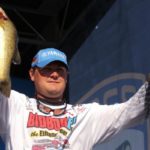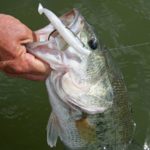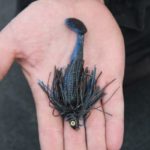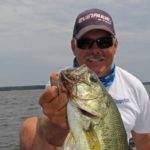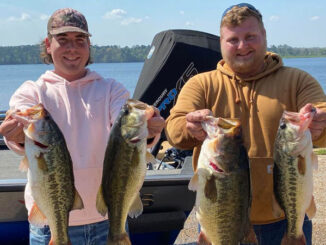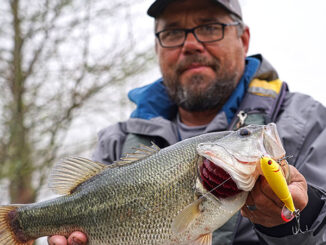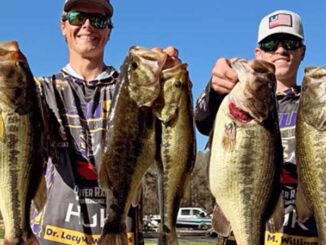
The prespawn is the perfect time to be on the water, since bass are fattening up for the coming rigors of the spawn. Here are how the pros put big fish in the boat.
Childbirth is one of life’s most-amazing moments.
But if you’ve ever been around a lady who’s closing in on D-day, you know you can count on a couple of behavioral points: moodiness and accelerated appetite.
Both are natural and understandable, so those close to the soon-to-be mother know to keep the fridge well stocked and allow for the temperamental stuff.
The same notions apply to largemouth bass, and when the prespawn period finds fish outside the spawning flats, bays and backwater coves where they’ll soon do their deal, their often finicky nature might compel anglers to pull out the finesse tactics.
However, anglers who make a living fishing — for instance, Bassmaster Elite Series’ Cliff Crochet from Pierre Part — know that, despite the occasional jittery tendencies of fish preparing for their shallowest move of the year, these gals are driven by a need to fill their bellies and pack on the calories in preparation for their forthcoming nest time.
Texas pro Todd Faircloth said it’s actually a great time to pound on the fish — particularly when they first begin thinking about the upcoming spawn.
“It seems like the earlier you are in the prespawn, the more aggressive the fish are,” Faircloth said. “When they get closer to the spawn and they’re fixing to go on the nest, they’re a little bit less aggressive.
“Also, it seems that if you get a warm afternoon, you can really catch some big fish in the afternoon. The water warms up and those fish get pretty aggressive. I’ve caught some of my biggest sacks this time of the year.”
Given the feeding motivation of the earlier prespawn weeks, a noisy, intrusive bait can stir up plenty of interest that leads to surprisingly aggressive bites. Sunlight and water clarity play big roles in this game, but Crochet won’t hesitate to go bold in the prespawn.
When looking for prespawn bass, consider these suggestions for bass-tempting baits:
Lipless crankbaits
In most scenarios, Crochet’s favorite prespawn bait is a Rat-L-Trap. Referring to the lipless crankbait as an “historic” lure that’s well-engrained in his angling psyche, Crochet likes the ability to cover a lot of water and look for those reaction strikes.
EverStart tournament pro Phil Marks also endorses the lipless crank, particularly ½-ounce Strike King Redeye Shad.
Marks lauds the bait’s rapid fire nature as a tactic of prespawn efficiency because, essentially, it’s about covering water to find those aggressive fish.
“A lipless bait is great because you can just machine gun it,” Marks said. “You can make a lot of casts, it comes through the grass easily and prespawn fish just like a lot of noise.”
Faircloth also likes lipless cranks, with ½-ounce version being his standard. However, he’ll vary the bait size based on the habitat he’s fishing.
He’ll use a ¼-ounce Redeye Shad over shallow hydrilla, milfoil or coontail, while deeper prespawn sites might justify a move to the ¾-ounce version.
Squarebill crankbaits
Bumping these lures off any hard cover will garner the attention of hungry prespawners.
Moreover, Marks pointed to the benefits of a floater/diver like the Strike King KVD 1.5 or 2.5 squarebill for post-frontal funkiness. Bumping cover remains a good strategy, but pausing the bait allows it to float topside and hold longer on the fish’s radar.
“During post-frontal conditions, when the fish (become less active), you can keep your bait in the strike zone longer,” Marks said.
Swimbaits
Crochet said his prespawn list definitely includes Luck E Strike Bass Magic swimbaits rigged on 6/0 weighted swimbait hooks.
The hook’s weight facilitates long casts, while the weedless rigging enables him to pull the bait through cover.
“The deal with the swimbait is that it’s a big profile,” Crochet said. “When the prespawn is going on, those big fish are in a bully-type mode, and they’ll take on anything. That swimbait has a big, full-bodied baitfish profile.”
One of the benefits of national-level competition is the firsthand exposure to various baits and fishing styles, and that’s helped Crochet appreciate the swimbait’s applicability in his home state waters.
“Up until a couple of years ago, (most) Louisiana anglers had no idea what a swimbait could do,” he said. “We always thought that it was for really deep water, really clear water, West Coast kind of deal.
“We’ve learned that is absolutely not true.”
Visibility does play into the equation, however.
“Clear water helps, but it doesn’t have to be 10 feet of visibility,” Crochet explained. “If you can see a foot, that’s good enough for me. You need to be able to see the bait in the water as you’re reeling it in. Of course, not at the end of a long cast, but as it gets 20 to 30 feet from the boat, you should be able to see that bait coming through the water.”
“The water doesn’t have to be crystal clear because the bait gives off a lot of vibration. If you can reel in a spinnerbait really fast and really high and see the whole bait, then that would be swimbait water.”
• Swim jig
Crochet’s also fond of a Humdinger swim jig for his prespawn searches because the bait’s straightforward simplicity makes it a dream for working around a variety of habitats with a variety of presentations.
“They’re real easy,” he said. “You can burn them; you can slow-roll them. No matter how you fish them, they’re real easy.
“A spinnerbait can be good too, but it has a lot of flash and vibration. That swim jig is nice and easy.”
He customizes his trailer to the water he’s fishing.
“It just all depends on the personality of the fish and what’s around in the environment,” Crochet said. “If you have a lot of bream and shad, I’ll go with a single-tail grub. If I’m fishing where I know there are a lot of crawfish, I’m going with a craw-type trailer.”
And the profile of the lure can be changed by careful trailer choices.
“You can take a swim jig and make it a finesse bait with a little tiny trailer, or you can put a big old grub on that rascal and make it a big old bait,” Crochet explained.
Faircloth’s also a swim jig fan, putting a ¼-ounce Strike King Tour Grade swim jig with a Rage Twin Tail Menace trailer to good use around available cover.
His common prespawn targets include wood, pad stems and grass.
Football-head jigs
One of the more-overlooked prespawn producers is the football-head jig. Dressed with a full skirt and active trailer, the rumbling package presents a big profile that bass mistake for a big, tasty crawfish or bluegill.
Crochet said the thing that makes the football-head jig a more-viable option for aggressive prespawners than, say, a flipping style jig is the mobility-based design.
“Everything we throw, from (flipping) jigs to plastics, we almost yo-yo it back,” he said. “But a football-head, you can drag it. That thing is going to walk on the bottom more than yo-yoing.”
There are limitations to the lure, however.
“I think the reason we don’t (use football-heads) in South Louisiana is because there’s so much mud and stuff on the bottom,” he said. “The football head is more of a rock or shell bed deal, but it’s probably something we’ve overlooked for a long time.”
Faircloth pointed to the barren humps in water at least 10 feet deep on Toledo Bend as a good option for dragging a football-head jig for prespawners.

